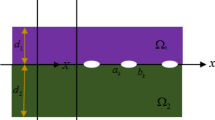Abstract
The fracture behaviour of metal-piezoceramic interfaces under mechanical and electrical loading is examined by four point bending using commercial multilayer actuators. The experiments are performed under stable crack growth in a custom made very stiff testing machine. Besides mechanical loading, a constant electric field was methodically switched on in longitudinal specimen direction. Both poled and unpoled actuators were tested. The crack morphology and the fracture toughness depend on the type of the metal-ceramic interfaces. Assuming different electrical crack boundary conditions of a permeable and an impermeable crack, the field intensity factors K ic , with i = 1, 2, 3, and energy release rates G c (K ic ) at the measured critical loads are evaluated with linear-piezoelectric finite element calculations. Inside the bounds of the electrically induced mixed-mode angles, the permeable crack boundary condition yields a constant interface toughness Γ.
Similar content being viewed by others
References
Anderson TL (1995) Fracture mechanics, fundamentals and applications, 2nd. CRC Press, Boca Raton
Balke H, Kemmer G, Drescher J (1997) Some remarks on fracture mechanics of piezoelectric solids. In: Michel B, Winkler T (eds) Proceedings of the International Conference and Exhibition of Micro Materials, Berlin, pp 398–401
Dawber M, Scott J (2001) Fatigue and oxygen vacancy ordering in thin film and bulk single crystal ferroelectrics. Integr Ferroelectr 32: 259–266
Fu R, Zhang TY (2000) Effects of an electric field on the fracture toughness of poled lead zirconate titanate ceramics. J Am Ceram Soc 83: 1215–1218
Guiu F, Algueró M, Reece MJ (2003) Crack extension force and rate of mechanical work of fracture in linear dielectrics and piezoelectrics. Philos Mag 83: 873–888
Häusler C, Balke H (2001) Der Grenzflächenriss zwischen einer Piezokeramik und einem Leiter. In: Haupt P, Kersten T, Ulbricht V (eds) Beiträge zur Modellierung und Identifikation. Berichte des Instituts für Mechanik, kassel university press GmbH, Universität Gesamthochschule Kassel, Kassel pp 57–66
Häusler C, Balke H (2005) Full form of the near tip field for the interface crack between a piezoelectric material and a thin electrode. Mater Sci Forum 492–493: 261–266
Häusler C, Gao CF, Balke H (2004) Collinear and periodic electrode-ceramic interfacial cracks in piezoelectric bimaterials. J Appl Mech 71(4): 486–492
Hutchinson JW, Suo Z (1992) Mixed mode cracking in layered materials. In: Hutchinson JW, Wu TY (eds) Advances in applied mechanics, vol 29. Academic Press, San Diego, CA, pp 63–191
Jelitto H, Keßler H, Schneider GA, Balke H (2005) Fracture behavior of poled piezoelectric PZT under mechanical and electrical loads. J Eur Ceram Soc 25: 749–757
Kuna M (2006) Finite element analyses of cracks in piezoelectric structures—a survey. Arch Appl Mech 76: 725–745
Lynch CS (1998) Fracture of ferroelectric and relaxor electro-ceramics: influence of electric field. Acta mater 46: 599–608
McMeeking RM (1989) Electrostrictive stresses near crack-like flaws. J Appl Maths Phys (ZAMP) 40: 615–627
McMeeking RM (2001) Towards a fracture mechanics for brittle piezoelectric and dielectric materials. Int J Fract 108: 25–41
Pritchard J, Bowen CR, Lowrie F (2001) Multilayer act uators: review. Br Ceram Trans 100(6): 265–273
Rice JR (1988) Elastic fracture mechanics concepts for interfacial cracks. J Appl Mech 55: 98–103
Schneider GA (2002) Fracture mechanical and mechanical properties of piezo-electric ceramics and piezoceramic/electrode interfaces under high electric fields. In: Setter N (eds) Piezoelectric materials and devices, Nava Setter. Ceramic laboratory, EPFL Swiss Federal Laboratory of Technology, Lausanne 1015, Switzerland, pp 195–210
Schneider GA (2007) Influence of electric field and mechanical stresses on the fracture of ferroelectrics. Annu Rev Mater Res 37: 491–538
Schneider GA, Felten F, McMeeking RM (2003) The electrical potential difference across cracks in PZT measured by Kelvin Probe Microscopy and the implications for fracture. Acta mater 51: 2235–2241
Weitzing H (2000) Schadensphänomene und bruchmechanische Charakterisierung piezokeramischer Multilayeraktoren. Dissertation, Shaker Verlag, Technische Universität Hamburg-Harburg
Zhang TY, Zhao M, Tong P (2001) Fracture of piezoelectric ceramics. In: van der Giessen E, Wu TY (eds) Advances in applied mechanics, vol 38. Academic Press, San Diego, CA, pp 147–289
Author information
Authors and Affiliations
Corresponding author
Rights and permissions
About this article
Cite this article
Häusler, C., Jelitto, H., Neumeister, P. et al. Interfacial fracture of piezoelectric multilayer actuators under mechanical and electrical loading. Int J Fract 160, 43–54 (2009). https://doi.org/10.1007/s10704-009-9408-6
Received:
Accepted:
Published:
Issue Date:
DOI: https://doi.org/10.1007/s10704-009-9408-6




